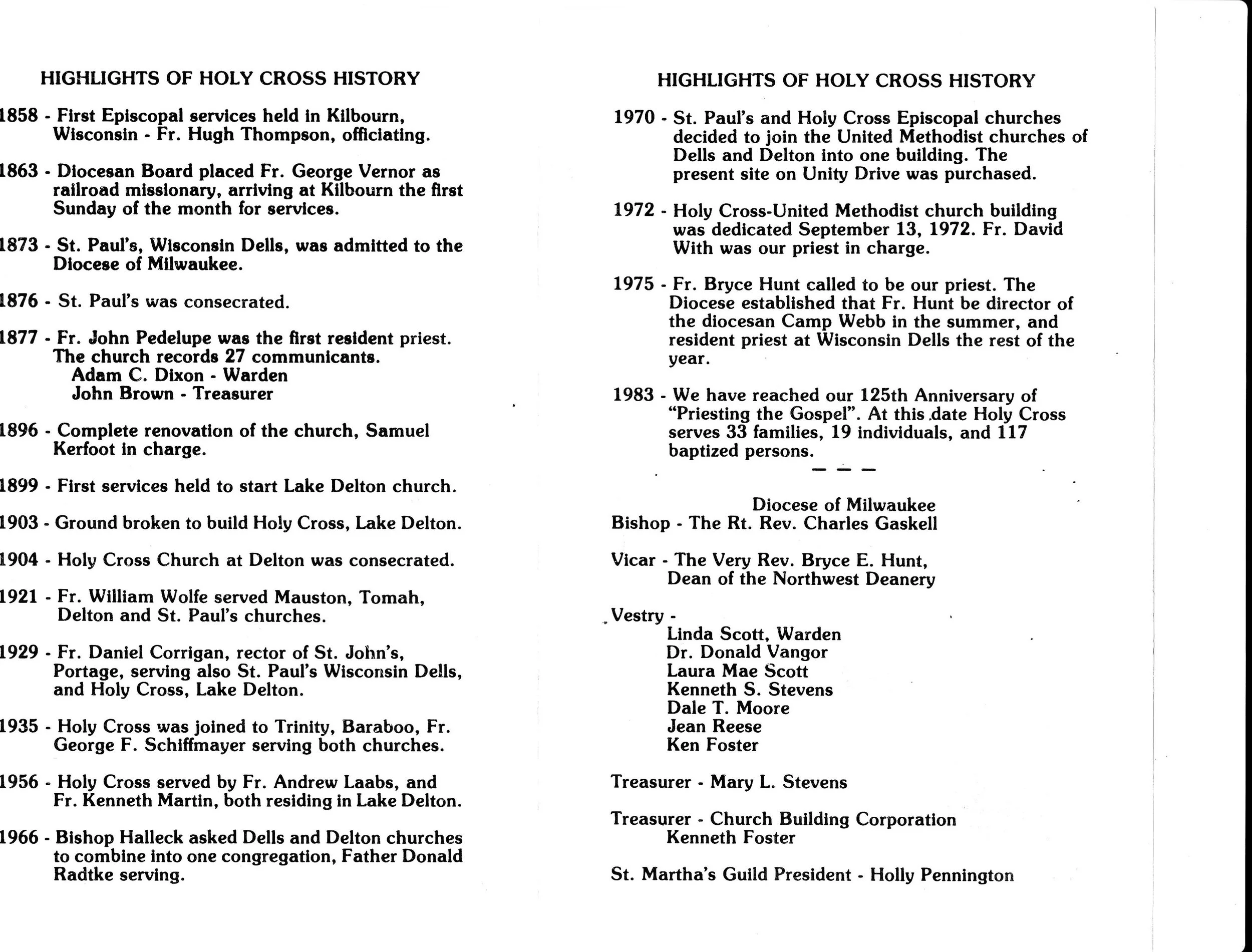Holy Cross: A Journey Through Time
Explore Our History:
Our story begins a few short years after Wisconsin became the 30th state. In 1858, as Newport thrived with 1500 residents on the lower Dells of the Wisconsin River, St. John's Episcopal Church was established in Portage. It was described as *"a church without a building, a prayer book, with 14 communicants, only three of whom were men."* The pioneering Rev. Hugh Miller Thompson, "Priesting the Gospel of Jesus Christ," served Portage. With knapsack on his back and icicles in his beard, he bravely traveled to Kilbourn to conduct the very first religious service there.
That inaugural Dells service took place in a schoolhouse, the future site of St. Paul's on Elm Street in Wisconsin Dells. Rev. Thompson continued his tireless work, even driving Bishop Jackson Kemper by sleigh across the frozen Wisconsin River to Newport and on to Baraboo, establishing another mission in the freezing cold.
Growth and Formal Organization
From 1860 to 1863, services were maintained by dedicated itinerant priests who rode the Milwaukee Road Railroad into the area. By 1867, with Kilbourn's population reaching 1500 and becoming the country's largest hops market, the Diocesan Board appointed Rev. George Vernor as a railroad missionary. He conducted services on the first Sunday of each month at Kilbourn and occasional weekday services, leading to the formal organization of St. Paul’s Mission.
A pivotal moment arrived in 1870 when Mary Greenly purchased the schoolhouse for $1000, generously donating the property to the church. Byron Kilbourn then contributed the adjoining lot to St. Paul’s. By 1873, St. Paul’s was formally accepted into the Diocese of Wisconsin, and its church building was consecrated in 1876.
Early Leadership and Enduring Legacies
The first resident priest, Rev. John Pedelupe, served from 1875-77, with church records noting 27 communicants. Remarkably, Rev. Pedelupe had converted from Roman Catholic to Episcopal. *(A wonderful connection was made in 2022 when we met his great-great-grandson, Daniel Hamm, who shared insights from his genealogical research!)* Rev. Pedalupe rests in Spring Grove Cemetery in the Dells.
In 1896, Mr. Samuel Kerfoot, whose summer home was Dawn Manor, played a crucial role in the revival of St. Paul’s. His contributions and fundraising efforts, coupled with Bishop Nicholson’s approval, led to a complete restoration and remodeling of the church. He gifted two beautiful stained-glass windows in memory of Julia Newbold Vibbert and Rev. James DeKoven, raising the church's value to $1500. *(These historic windows can still be admired in our present-day Fellowship Hall.)*
Rev. Arthur Gorter, a deacon, took charge in 1897. The congregation faced challenges: only 13 confirmed persons, 7 communicants, an average age of 58, and notably, "no children, no young people, no organist, no choir."
The Birth of Holy Cross in Delton
A new chapter began on June 25, 1899, with the first service at Holy Cross in Delton. Ground was broken by E.T. McCutchen, a Lay Reader and future rector for both churches, and Milo B. Goodall, a stone mason who also became a priest.
Holy Cross Church in Lake Delton was consecrated by Bishop Nicholson on July 22, 1904. Fr. McCutcheon was priested at St. Paul’s on the Fourth Sunday of Advent, December 1907. His dedication was profound: leaving Kilbourn on the 9 o’clock train for services in Mauston, returning at 3 o’clock, driving to Delton for 4 PM services, and then back to Kilbourn for evening services.
Consolidation and Ecumenical Spirit
During 1910–20, Lois and Phyllis Crandall organized a high school choir. In 1921, Fr. William Wolfe began serving Mauston, Tomah, Delton, and Kilbourn, and a Ladies Guild was organized. Fr. Wolfe served these parishes until 1929. When the Diocese of Eau Claire was formed, Mauston and Tomah moved into its jurisdiction, establishing that the rector of St. John’s Portage would also serve St. Paul’s and Holy Cross. This role was filled by Rev. Daniel Corrigan, who later became Suffragan Bishop of Colorado.
Fr. Donald Means served all three churches until 1935. Subsequently, Fr. George Sciffmayer, the priest at Baraboo, took over serving Holy Cross Lake Delton and Trinity Baraboo until 1956.
St. Paul’s Wisconsin Dells and Holy Cross Lake Delton were then encouraged by the Diocese to combine into one congregation. For six months, services rotated between buildings, with Fr. Daniel Radtke officiating. This period led to the decision to construct a single new church, and a site was purchased strategically between the Dells and Delton.
Fr. David Wirth became our vicar in 1970, spearheading a unique ecumenical adventure: four churches came together with the United Methodists to build a single structure at our current location. A corporation was formed, and this unified church building was dedicated on September 13, 1972.
Fr. Bryce Hunt was called in 1975 as our resident vicar, also directing the diocese’s summer camp in Wautoma, Camp Webb.
Our Dedicated Priests (1971 - Present):
- 1971-75: Dennis Day
- 1975-82: Bryce Hunt
- 1988-94: Robert Coval (d 2-21-2019)
- Robert Jelliffe (d)
- 1996-99: Debra Trakel
- 1999-2006: Diane Markevitch
- 2007-12: Joan Smok
- 2014-17: Al Majkrzak (d 09-27-21)
- 2018-19: Ulis Dean Hekel (long term supply)
- 2019-21: Mike McElwee
- 2022: Thomas McAlpine, James Kaestner, Nigel Bousfield, Pastor Mark Teslik (all supply)
- 2022-present: Michael Caldwell


